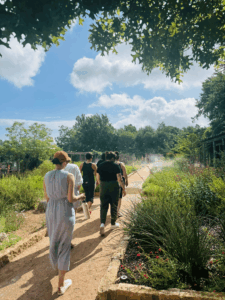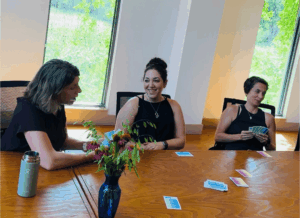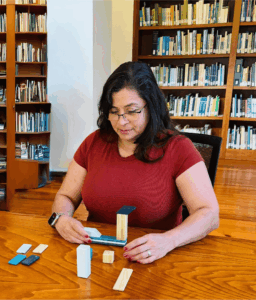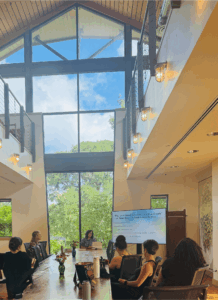
What role does play have in the workplace? According to researchers, and our own experience facilitating workshops that include experiential play, far more than most people expect. Play is not just recreation, it is a powerful tool that directly shapes how people relate and organizations function. When thoughtfully integrated, play fosters connection, unlocks creativity, and strengthens collaboration—fueling cultures where people thrive and business results accelerate.
 As part of a recent intensive week for the University of Texas HDO Master’s cohort, we co-lead a workshop on the importance of play in organizational life. Held at the Lady Bird Johnson Wildflower Center and coordinated by HDO alum and Manager of Volunteer Services, Carrie McDonald (HDO MA’23), the day began with her tour of the grounds and a conversation on mindfulness in the workplace. This set the tone for a meaningful and engaging session (photo courtesy of Heather Moreau).
As part of a recent intensive week for the University of Texas HDO Master’s cohort, we co-lead a workshop on the importance of play in organizational life. Held at the Lady Bird Johnson Wildflower Center and coordinated by HDO alum and Manager of Volunteer Services, Carrie McDonald (HDO MA’23), the day began with her tour of the grounds and a conversation on mindfulness in the workplace. This set the tone for a meaningful and engaging session (photo courtesy of Heather Moreau).
The Case for Play
When you hear the word play, what comes to mind? Is it something unstructured, something for children, or for creative time off the clock? What if play isn’t just a break from work—what if it is a key to how we work best?
Dutch historian Johan Huizinga didn’t see play as frivolous. He argued that it’s a fundamental part of human culture, shaping how civilizations develop and thrive. And it’s not just a human trait—play shows up across species, helping to build social bonds, teach boundaries, and guide behavior.
What makes play so powerful? Huizinga described it as voluntary, happening in a defined space and time, marked by joy, focus, and just enough tension to stretch us. When we play, we step into what he called the magic circle—a space apart from our daily routines, where familiar rules pause and new possibilities emerge. Inside this circle, we can experiment, imagine, and connect in ways that often feel out of reach in everyday work.
Modern research confirms what Huizinga saw: play isn’t just cultural. It’s psychological, social, and even neurobiological. And in our complex, fast-changing work environments, play is an essential and practical way to build stronger teams, spark innovation, and help people navigate uncertainty with confidence.
Two Playful Pathways: Metaphoria and Can You Build It
Our workshop featured two interactive experiences that we developed from our respective HDO capstone work and that we use in our consulting practices.
Metaphoria, created by Thresa, is a metaphor-based card game that invites players to explore complex topics through metaphors. Rooted in her capstone research on metaphors and play, the game draws inspiration from Metaphors we Live By (Lakoff & Johnson, 1980) and Johan’s Huizinga’s play research. It explores how metaphors shape our understanding, and how reimagining them through play can transform the way we perceive, connect, and engage with the world.

Metaphoria consists of two card decks, Metaphors and Topics. Players begin by choosing a topic—anything from leadership to curiosity. Each participant draws metaphor cards and players then use those metaphors to describe their perspective on the topic, sparking reflection, storytelling, and conversation. In play, participants tend to listen more deeply, take creative risks, and surface insights that rarely appear in conventional settings. Vulnerability happens naturally. The rules are simple: stay curious, listen well, and let the metaphors guide the dialogue. Everyone wins because of deeper understanding (photo courtesy of Cyndee Lake).
The experience is especially valuable across cultures and generations. While metaphors are universal, they are also culturally dependent. Metaphoria reminds us that language is nuanced, that multiple truths exist a once, and that differing viewpoints are not threatening, but valuable.

Can You Build It, designed by Cyndee, is a popular experiential challenge that combines urgency, fun, and discovery to help teams explore what it takes to perform at a high level. In this fast-paced, time-bound activity, teams work to build a structure that only one person can see. With no time to plan, assigned roles (Looker, Messenger, Builder, Observer), and tight time limits, teams jump into action, where familiar habits and instinctive communication styles quickly take over. Laughter, energy, and high engagement fill the room as teams navigate the challenge together (photo courtesy of Heather Moreau).
The setup creates a vivid microcosm of how teams communicate, decide, and collaborate under pressure. People naturally focus on what seems most helpful from their own role, making rapid decisions about what details matter, what to share, and how to balance strategy with action. Patterns emerge—dialogue or monologue, iteration, or one-way direction—and while the team often assumes they are competing with other teams, the real opportunity lies in learning with and from each other to move faster and smarter.
The experience sparks personal insight and team reflection in a nonjudgmental way. It helps groups spot where small cracks in shared understanding can grow into gaps and moves them toward concrete agreements about what exceptional communication, decision-making, and collaboration norms need to look like to achieve great work together.
What Emerged
During our final reflection, cohort members shared that they discovered new things about themselves and each other—insights that felt authentic, not theoretical. They spoke of trust, compassion, and communication, and reflected on the assumptions and patterns that shape how we work together in various environments. Through play, they noticed the invisible rules they followed without question, and what shifted when those rules changed or disappeared.

Both Can You Build It and Metaphoria gave teams a shared language and common experience. The activities created space for honest dialogue, creative risk-taking, and deeper listening. Participants recognized that their default ways of communicating, deciding, and collaborating could either build connection or create distance—and that reimagining these patterns opens new possibilities. The experiences successfully reinforced that differing viewpoints, like differing metaphors, are not barriers, but sources of strength, especially across cultures, generations, and perspectives (photo courtesy of Heather Moreau).
The Role of Play in Organizational Culture
Culture is the invisible fabric of daily experience. It is the shared patterns of behavior, values, beliefs, and unspoken rules that shape how people work, interact, and make decisions together.
Play is a powerful way to reveal and shape culture in the following ways:
- Surfaces hidden dynamics in a low-stakes setting,
- Creates a safe container for vulnerability and emotional honesty,
- Encourages listening, improvisation, and perspective-taking,
- Builds shared experience and trust, and
- Models inclusive behavior and disrupts unhelpful patterns.
In the magic circle of play, participants explore alternatives to their habitual roles and reactions. Because the setting feels less threatening, they are more likely to take interpersonal risks, show up as themselves, and try new behaviors. These small shifts, when repeated and recognized, have the potential to reshape the cultural DNA of an organization.
Culture and Structure in Motion
Culture and structure aren’t just separate forces—they constantly shape and influence each other. Culture can reinforce or resist structure; structure can enable or constrain culture.
Play sits at the intersection, offering a safe, dynamic space to explore how culture and structure actually show up in action. It’s not a break from the real work. It is the work!
About the Authors:
Cyndee Lake is Chief Purpose Officer and Co-Founder of Blank Page, LLC, and GuideLabs where they are on a mission to democratize how people amplify their value and impact every day.
Thresa Nasi is Founder of Thought Meadow, LLC. She invites members of organizations to slow down, reflect, and connect in new ways. She leads strategic planning and designs interactive, metaphor-based workshops that help teams navigate complexity and improve engagement.
